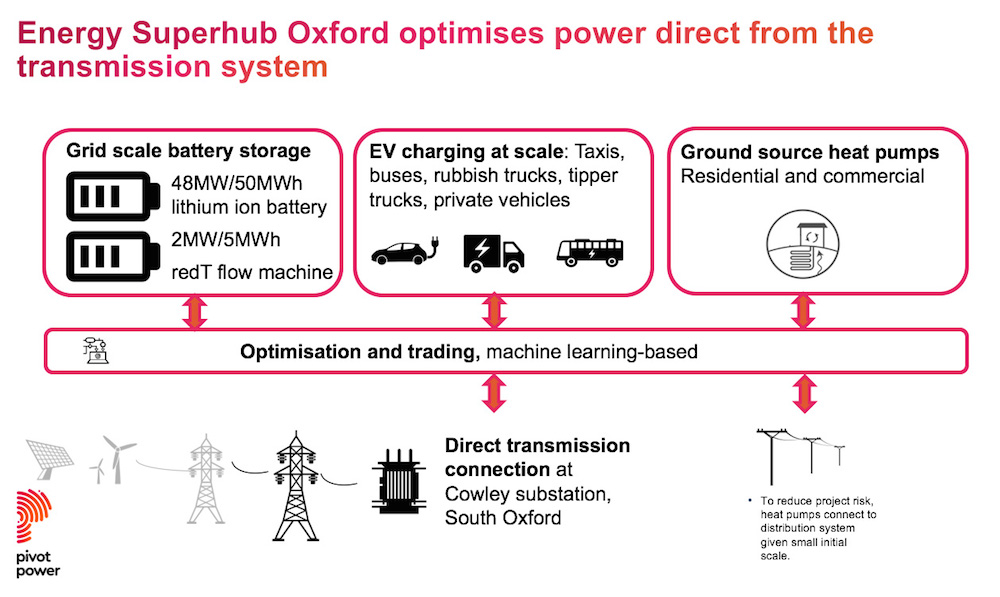A £41m world-first Energy Superhub will be built in Oxford, making it a model for cities around the world to cut carbon and improve air quality, the consortium announced. The consortium partners are Oxford City Council, Pivot Power, Habitat Energy, Kensa Contracting, redT energy and the University of Oxford.
The City of Oxford will pioneer a model of rapid transport and heat electrification that can be rolled out to other cities to reduce air pollution and support government plans to decarbonise the UK economy. Energy Superhub Oxford will demonstrate an ecosystem of practical decarbonisation approaches by applying machine learning and grid scale energy storage infrastructure to bypass network constraints. The project aims to reduce emissions and improve public health by accelerating a switch to electric vehicles and decarbonising heating for homes and buildings to support Oxford City Council’s journey to zero carbon. Smart software will manage the energy storage, electric vehicle charging and heat pumps, to reduce strain on the grid and allow it to accommodate more renewables. The project aims to save 20,000 tonnes of CO2 per year by 2021, rising to 44,000 tonnes per year by 2032. UK Research and Innovation (UKRI) will contribute c.£10m to support the £41m project.
Earlier this year the City Council declared a climate emergency in Oxford and committed to continue working with partners across the city and region to deliver widespread carbon reductions. Oxford City Council is a member of Low Carbon Oxford, a network of 40 public/private organisations that aims to reduce citywide emissions by 40% of 2005 levels by 2020.
Zero Carbon Oxford
Councillor Tom Hayes, Executive Board Member for a Safer and Greener Environment said: “The City Council is working towards a Zero Carbon Oxford to tackle dangerous climate change in the time available to us to save the planet. Uniquely, this £41m once-in-a-generation downpayment on Oxford will move the Council closer to achieving this vision. Leading businesses are investing in Oxford because they recognise that we’re already trialling new technologies exactly like Energy Superhub Oxford. The announcement allows us as a city to embrace our technological future.
“This exciting project will enable the City Council to install more electric vehicle charging points of the kind that charge vehicles quickest. It gives Black Cab drivers additional support to shift from 100% diesel today to 100% electric in the next few years. It enables the council to move our own vehicles to electric on a faster timescale and, crucially, to install heat energy across homes to tackle fuel poverty.”
By 2020 the Energy Superhub Oxford consortium will launch the world’s largest commercial hybrid energy storage system (50 MW) and a network of ultra-rapid and fast charging stations connected directly to National Grid’s extra-high voltage transmission system. Pivot Power’s private-wire network across south Oxford will have enough power to charge hundreds of vehicles at the same time. Money-saving ground source heat pumps from Kensa will subsequently be installed in c.300 buildings and homes.
The council will use some of the UKRI grant to convert part of its vehicle fleet to electric, with aims to procure new electric vehicles including refuse collection trucks, sweepers, tippers and vans. The funding will also support the Council to work with a partner offering a ‘Try before you Buy’ programme for Hackney Carriage Vehicle drivers in Oxford. This will assist the transition of the black cab fleet from 100% diesel to 100% electric by 2025.
Habitat Energy will develop the optimisation platform for the project which will control the energy storage, importing and exporting power to help balance the grid second by second, giving it the flexibility to bring more wind and solar onto the system. The optimisation platform will also manage the electric vehicles and heat pumps, maximising their use of cheap energy and using them to provide additional flexibility to the electricity network.
Ground Source Heat Pumps
From 2020 to 2021 Kensa Contracting will design and install ground source heat pump systems in 300 homes using an innovative shared ground loop system that sees each household with an individual Kensa Heat Pump connected to a larger ambient temperature district heating network. Running costs for this type of system compare well to mains gas boilers, with half the carbon footprint. The optimisation platform is expected to cut heating bills and carbon emissions by a further 25%, developing a tailored plan for each home based on its heat profile and taking advantage of time-of-use tariffs to shift heating demand away from expensive, high carbon times and maximise the use of low carbon, cheap, off-peak power.
Dr. Matthew Trewhella, Managing Director of Kensa Contracting said: “Ground source heat pumps are a tried and tested technology that have been shown to produce significant carbon savings, low running costs and zero point of use air pollution. The rapid decarbonisation of the electricity grid over the last five years has added more momentum in the push towards the electrification of heat.
“There have been concerns expressed that shifting load from fossil fuels such as oil, LPG and ultimately mains gas will unduly increase the strain on the electricity grid beyond its capacity — particularly at peak times. By using smart controls that learn the occupant’s preferences and building heat physics, it will be possible to avoid the peaks of grid strain and shift load to the times when the grid can best accommodate it. Better still, these times also have lower carbon and lower cost electricity, which further increases the appeal of ground source heat pumps. This combination means that ground source heat pumps transform from being a potential strain on the grid to becoming part of the solution. When added to the battery storage and electric vehicle charging elements of this project, it creates a powerful energy system that is fit and ready for a low carbon future.”

Hybrid solution
The project will see Pivot Power install the world’s largest hybrid lithium ion/vanadium redox flow machine energy storage system (50 MW). It will combine the high-power capabilities of a lithium-ion battery with 2MW/5MWh of the heavy cycling, non-degrading characteristics of vanadium redox flow machines, supplied by UK energy storage experts, redT energy. Utilising both lithium-ion batteries and vanadium redox flow machines together in one hybrid system, combines the strengths of the two technologies to meet the complex demands of multiple applications while extending the lifespan of the lithium-ion battery.
The use of redT’s flow machine technology, Habitat’s pioneering real-time energy optimisation and trading capacity incorporating degradation management for the lithium-ion element, and the Kensa shared loop ground source heat pump technologies will make the Energy Superhub Oxford project one of the largest examples of real-world Smart Local Energy Systems across energy vectors.
The University of Oxford will evaluate the performance of the energy storage system, and assess the environmental, social and economic impacts of the project on local stakeholders. This will lead to insights into governance and reproducibility, as well as validated performance models of large-scale battery systems. Government plans to cut carbon emissions and improve air quality could see millions of electric vehicles and heat pumps in use by 2030, and the project will show how this can be achieved while maintaining a stable, efficient, cost-effective electricity network.
Energy and Clean Growth Minister, Claire Perry said: “Oxford is set for a smart energy overhaul, with these projects aiming to meet the city’s energy needs through greener, low carbon technologies. Backed by government funding, this has the potential to completely change the way people go about their daily lives — from going to work on an electric bus to using the heat rising from the earth to heat your home without gas.
“These projects are an example of our modern Industrial Strategy in action, helping companies and consumers seize the opportunity of the global shift to a cleaner, greener, more flexible energy system.”
UK Research and Innovation
Rob Saunders, Deputy Challenge Director, Prospering from the Energy Revolution, UK Research and Innovation added: “We all need energy systems that are cheaper, cleaner and consumer-friendly. We have a great opportunity with the Energy Superhub to show just how innovation can deliver this energy ambition for the future. Supported by the Industrial Strategy Challenge Fund, this project can drive investment, create high-quality jobs and grow companies with export potential.”
The Smart Local Energy Systems Demonstrator grant will significantly accelerate the delivery timescales of the Energy Superhub. The project is funded by UK Research and Innovation through the Industrial Strategy Challenge Fund. Project Local Energy Oxfordshire (LEO) led by Scottish and Southern Electricity Networks (SSEN) has also received funding. LEO will explore how the growth in local renewables, electric vehicles (EVs), battery storage, and demand side response can be supported by a local, flexible, and responsive electricity grid unlocking new opportunities for consumers and market providers.
The University of Oxford, together with a UK university-led energy revolution research consortium dubbed EnergyREV and the Energy Systems Catapult ‘Energy Revolution Integration Service’ (ERIS) will study the project to produce reports and recommendations that will support the rollout of similar initiatives elsewhere in the UK, and around the world.
Power infrastructure
Pivot Power: Matthew Boulton, Chief Commercial Officer commented: “We are providing the power infrastructure needed to kick-start an electric vehicle revolution in Oxford and support the city’s ambitious plans to clean up its air and cut its carbon emissions. We’re thrilled that our network will enable the city council to start transitioning its entire vehicle fleet across to electric. We are hoping to encourage all sorts of other Oxford groups — residents, commuters, bus companies, logistics operators — to take advantage of the power we are bringing to the south of the city and switch to electric vehicles. Together we can make rapid improvements to Oxford’s air quality and turn it into a global showcase of a clean electric city.
“The UKRI grant allows us to be bolder and move more quickly with our EV network, and allows us to demonstrate exciting UK-based flow machine technology, which should have a key role to play in the future as longer-duration energy storage technologies are required to balance the grid; Our partner Habitat will be sitting in the middle of the whole proposition, developing cutting edge software which will be able to optimise both a 50 MW energy storage system and a network of c.300 (2kW) heat pumps — a perfect demonstrator of what our digitised grid will need to look like in the future when we are relying on thousands of decentralised assets and distributed renewable energy generators, not just a few big power stations.”
Habitat Energy: Andrew Luers, Cofounder and CEO, said: “At Habitat Energy our aim is to enable a flexible, renewables-powered energy grid and transportation network. Battery storage, EV charging and heat pumps are some of the essential elements of this network. With the Energy Superhub Oxford project we’re excited to demonstrate with our partners how our innovative platform coupled with these assets can accelerate the transition to a renewables-powered world while providing investable returns that allow this approach to scale across the UK and beyond.”
redT energy: Scott McGregor, CEO, added: “We’re proud to be involved in this ground-breaking hybrid grid storage project. This will be the largest deployment of our heavy-cycling flow machines in the UK to date and the largest vanadium/lithium hybrid system to have been installed globally. The ESO project is essential infrastructure for the inevitable energy transition required to support electric vehicles, and we at redT are pleased to be a key part of it.”
University of Oxford, Department of Engineering, Professor David Howey said: “We’re delighted and extremely excited to be involved in such a large project right on our doorstep which really will have a step change impact on local transport and energy systems.”
Pictured above is the battery storage and heat pumps to feature at the Energy Superhub Oxford.









